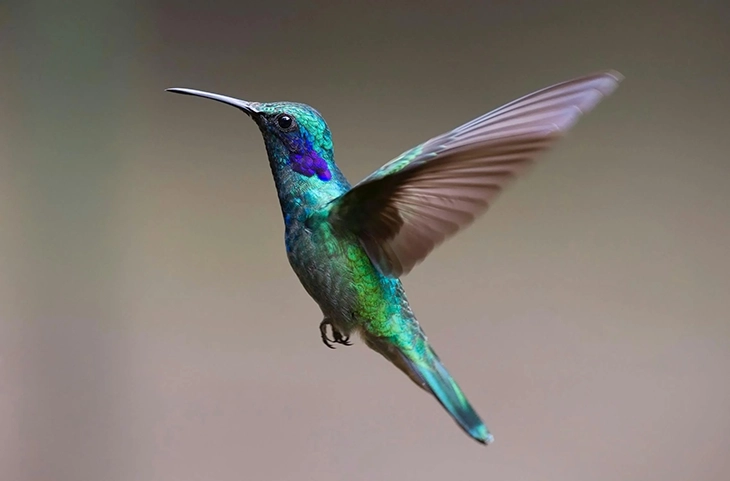

Hummingbirds aren’t just the dainty, colorful creatures we love to watch darting around flowers—they are living marvels of survival, defying nature’s most extreme demands with an audacity that will leave you speechless. These tiny, high-speed acrobats push the boundaries of biology in ways that seem almost too outlandish to believe.
Forget everything you thought you knew about their “easy” lifestyle. These birds are pushing their bodies to the brink, burning through sugar in ways that would send any human into a sugar coma. Their metabolism is on overdrive every second of the day, a mind-boggling feat that demands scientific attention and awe.
But don’t just take our word for it. “They’re the only bird in the world that can fly upside down and backwards,” says Holly Ernest, a conservation ecologist at the University of Wyoming. Yes, you read that right—these creatures defy gravity itself with gravity-defying maneuvers. And just to add to the absurdity, “They drink pure sugar and don’t die of diabetes,” Ernest adds. How, you might ask? That’s the million-dollar question, and it’s time to unravel the secrets.
For hummingbirds, it’s all about sugar—guzzling nectar by the gallon. But what might seem like an innocent sweet tooth is actually a full-throttle metabolic explosion. These birds don’t just nibble at flowers; they consume 80% of their body weight in nectar each day, a feat that would make anyone else spiral into a coma. Imagine consuming nearly 100 sodas a day without ever suffering from a crash or the long-term health consequences that plague humans.

And here’s where it gets even more bizarre: hummingbirds maintain blood sugar levels up to six times higher than a human’s without any of the side effects we would experience from such extreme sugar levels. How is this possible? “There could be a gold mine in the genome of the hummingbird,” says Ken Welch, a comparative physiologist at the University of Toronto at Scarborough. These birds seem to have unlocked an evolutionary cheat code to handle sugar in ways we can only dream of. What if these findings could one day revolutionize how we treat diabetes?
But even with this crazy amount of sugar coursing through their veins, hummingbirds face real, life-or-death challenges. Every night, they drop into what can only be described as a deep, comatose state called torpor, lowering their body temperature to near-freezing levels to conserve energy. Think of it as a metabolic power save mode, allowing them to survive nights when food is scarce. This strategy can save them up to 95% of their metabolic costs during cold nights, helping them survive long periods of fasting or prepare for long migrations.

Anusha Shankar, a physiological ecologist, studied this process in Southern Arizona and was left astounded. “That’s 13 hours a day! There’s no way I can spend 13 hours a day running. I don’t know how they do it,” she says, marveling at their stamina. Indeed, it’s a lifestyle few other creatures on Earth could ever dream of mimicking.
Think of a hummingbird’s life as a high-speed chase—racing through the skies, zig-zagging between flowers, while its metabolism burns through energy at rates unseen in any other species. These birds don’t just flutter about; they engage in an extreme, high-stakes game of survival. Their muscles generate forces so intense during their hovering flight that they sometimes experience g-forces comparable to what fighter pilots endure.

How do they manage it all? It’s their ability to switch metabolic gears, “from sugar-burning to fat-burning in mere minutes,” says Ken Welch. While most animals struggle to make such a transition, these little powerhouses can do it in seconds. This metabolic flexibility could provide humans with valuable insights into managing energy usage in extreme conditions—something athletes, astronauts, and even patients with metabolic disorders could benefit from.
But the high-stakes game isn’t just about energy. The challenges of high-altitude living, such as those faced by the giant hummingbird in the Andes, add an entirely new layer of complexity. These birds live in the thin air of the mountains at over 14,000 feet—higher than many helicopters can reach—where oxygen is scarce and the air is thin. To survive, they’ve developed more hemoglobin-rich blood, an adaptation that lets them extract more oxygen with each breath.
And it gets even more fascinating. Jessie Williamson, an ornithologist at Cornell University, uncovered a stunning discovery when tracking these high-altitude fliers. Some of these giant hummingbirds make the perilous 5,000-mile journey every year from Chile to the Andes, proving that migration is not only about endurance, but also about gradual acclimatization to thinner air, much like how human mountaineers summit Everest. A slow, careful adjustment is key to surviving the long journey and making it to the highest peaks.

What’s clear is that hummingbirds are far from the delicate, fragile creatures many perceive them to be. Instead, they are incredible athletes—part metabolic miracle, part flying superhero. From their sugar-driven engines to their gravity-defying flight and secretive metabolic tricks, these birds are on the front lines of evolutionary innovation. Their survival strategies, honed over millions of years, could one day hold the answers to some of our most pressing health and scientific challenges.
So, next time you spot a hummingbird zipping by, take a moment to appreciate just how extraordinary this tiny creature really is. It’s not just another bird—it’s an evolutionary powerhouse, mastering the extreme lifestyle we could only dream of.
What are your thoughts? Please comment below and share this news!
True Activist / Report a typo







